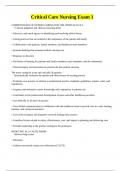Critical Care Nursing Exam 1
COMPETENCIES OF NURSES CARING FOR THE CRITICALLY ILL -
• Clinical judgment and clinical reasoning skills
• Advocacy and moral agency in identifying and resolving ethical issues
• Caring practices that are tailored to the uniqueness of the patient and family
• Collaboration with patients, family members, and healthcare team members
• Systems thinking that promotes holistic nursing care
• Response to diversity
• Facilitator of learning for patients and family members, team members, and the community
• Clinical inquiry and innovation to promote the best patient outcome
The nurse caring for acute and critically ill patients: -
Systematically evaluates the quality and effectiveness of nursing practice
• Evaluates own practice in relation to professional practice standards, guidelines, statutes, rules, and
regulations
• Acquires and maintains current knowledge and competency in patient care
• Contributes to the professional development of peers and other healthcare providers
• Acts ethically in all areas of practice
• Uses skilled communication to collaborate with the healthcare team to provide care in a safe, healing,
humane, and caring environment
• Uses clinical inquiry and integrates research findings into practice
• Considers factors related to safety, effectiveness, cost, and impact in planning and delivering care
• Provides leadership in the practice setting for the profession
REDUCING ALL-CAUSE HARM -
Adverse drug events
• Infections
• Catheter-associated urinary tract infections (CAUTI)
,• Central line-associated bloodstream infections (CLABSI)
• Surgical site infections
• Ventilator-associated pneumonia (VAP)
• Injuries from falls and immobility
• Obstetric adverse events
• Pressure ulcers
• Venous thromboembolism (VTE)
• Other hospital-acquired conditions
AMERICAN ASSOCIATION OF CRITICAL-CARE NURSES' LEVELS OF RESEARCH
EVIDENCE -
A
Meta-analysis of multiple controlled studies or metasynthesis of qualitative studies with results that
consistently support a specific action, intervention, or treatment
B
Well-designed controlled studies, both randomized and nonrandomized, with results that consistently
support a specific action, intervention, or treatment
C
Qualitative, descriptive, or correlational studies; integrative reviews; systematic reviews; or
randomized controlled trials with inconsistent results
D
Peer-reviewed professional organizational standards, with clinical studies to support recommendations
E
Theory-based evidence from expert opinion or multiple case reports
M
Manufacturer's recommendation only
BARRIERS TO EFFECTIVE HANDOFF COMMUNICATION -
• Physical setting: background noise, lack of privacy, interruptions
,• Social setting: organizational hierarchy and status issues
• Language: differences between people of varying racial and ethnic backgrounds or geographical areas
• Communication medium: limitations of communications via telephone, e-mail, paper, or
computerized records versus face-to-face
SBAR APPROACH -
S—Situation: State what is happening at the present time that has warranted the SBAR
communication.
B—Background: Explain circumstances leading up to this situation. Put the situation into context for
the reader/listener.
A—Assessment: State what you think is the problem.
R—Recommendation: State your recommendation to correct the problem.
ITEMS TO CONSIDER IN DAILY MULTIPROFESSIONAL ROUNDS -
• Discharge needs, Greatest safety risk, Implementation of ventilator "bundle", Head-of-bed
elevation, Titration of sedation for assessing readiness to extubate, Prophylaxis for peptic ulcer disease,
Prophylaxis for venous thromboembolism, Assessment and recommended follow-up, Cardiac and
hemodynamic status, Volume status, Neurological status, Pain management, Sedation needs,
Gastrointestinal status, including bowel management, Nutrition, Skin issues, Activity, Infection status
(culture results/therapeutic levels of antibiotics), Laboratory results, Radiological test results, Assess
need for all ordered medications, Identify whether central lines and invasive catheters/tubes can be
removed, Identify whether indwelling urinary catheter can be removed, Issues that need to be
addressed, Family needs—educational, psychosocial, spiritual, Code status, Advanced directives,
Parameters for calling the physician, Treatment goals and strategies to achieve them, Plans for
discussing care and needs with families
NOISE LEVELS ASSOCIATED WITH PATIENT CARE DEVICES AND ACTIVITIES -
Call-bell activation-48-63
Oxygen/chest tube bubbling-49-70
Conversations (staff, patients, and family)-59-90
Voice over intercom-60-70
Telephone ringing-60-75
Television (normal volume at 12 feet)-65
Raising/lowering head of bed-68-78
Cardiac monitor-72-77
Infusion pump-73-78
Ventilator sounds-76
Pneumatic tube arrival-88
BEST PRACTICES IN AWARD-WINNING CRITICAL CARE DESIGNS -
Larger units-Units with more beds and increased space
Patient rooms-Private rooms of about 250 sq ft; increased space if accommodating space for family
members
, Family zone-Designated family/visitor space in the unit, and often in the patient room
Technology-Redesigned for functionality; increased use of ceiling mounted equipment rather than
headwall systems
Team space-Designated staff work stations
Proximity to diagnostics and treatment-Ready access to diagnostic testing equipment; more portable
equipment that can be brought to the bedside
Administrative space-Increased space for administrative staff and education
Unit geometry-Varied; pod concept has been popular
Access to nature-Access to natural elements for patients, family, and staff members increasing
PATIENTS' RECOLLECTION OF THE CRITICAL CARE EXPERIENCE -
Difficulty communicating, Pain, Thirst, Difficulty swallowing, Anxiety, Lack of control, Depression,
Fear, Lack of family or friends, Physical restraint, Feelings of dread, Inability to get comfortable,
Difficulty sleeping, Loneliness, Thoughts of death and dying
Decision making -
• Make decisions based on a partnership between the patient, family, and the healthcare team.
• Communicate the patient's status and prognosis to family members and explain options for treatment.
• Hold family meetings with the healthcare team within 24 to 48 hours after intensive care unit (ICU)
admission and repeat as often as needed.
• Train ICU staff in communication, conflict management, and facilitation skills.
Family coping -
• Train ICU staff in assessment of family needs, stress, and anxiety levels.
• Assign consistent nursing and physician staff to each patient if possible. Update family members in
language they can understand. Keep the number of staff members who provide information to a
minimum.
• Provide information to family members in a variety of formats.
• Provide family support using a team effort, including social workers, clergy, nursing and medical
staff, and support groups.
Staff Stress -
• Keep all healthcare team members informed of treatment goals to ensure that messages given to the
family are consistent.




